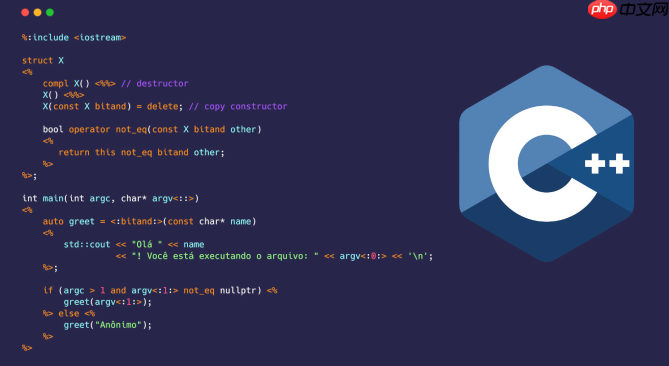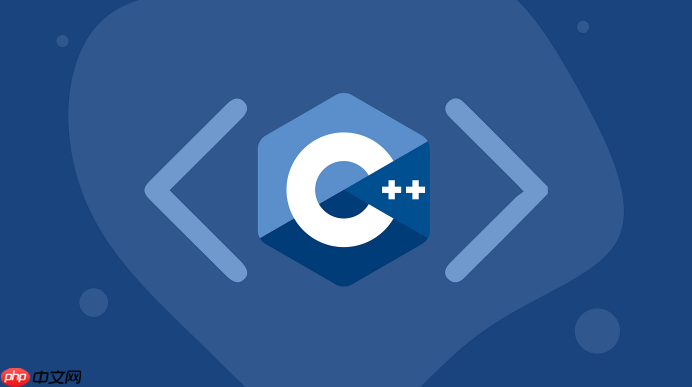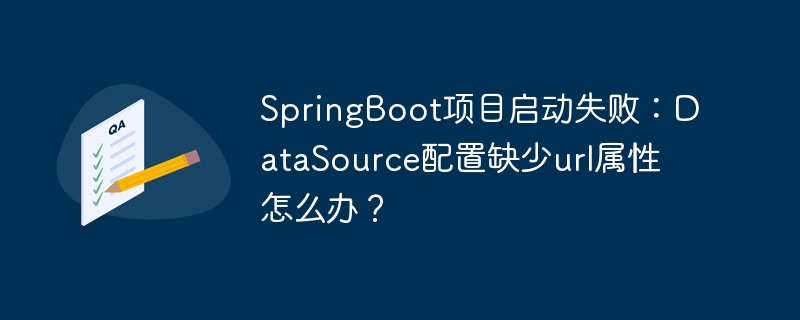c++++17的std::Filesystem库相比传统方法具有显著优势,1. 它提供了跨平台的统一接口,自动处理不同系统的路径分隔符,避免了平台相关的代码;2. 使用面向对象的设计,如path类,使路径操作更直观、安全;3. 引入异常处理和错误码机制,提升错误反馈的清晰度与代码健壮性;4. 支持raii资源管理,简化文件句柄等资源的释放;5. 提供丰富的文件和目录操作函数,如创建、遍历、拷贝、删除等,增强开发效率。

c++17的std::filesystem库,说白了,就是一套现代的、跨平台的、面向对象的文件系统操作接口。它彻底改变了我们在C++中处理文件和目录的方式,告别了过去那些平台特定的、C风格的API,让文件操作变得统一而优雅。

解决方案
使用std::filesystem,你首先需要包含
#include <iostream> #include <filesystem> // 核心头文件 #include <fstream> // 用于文件内容操作 namespace fs = std::filesystem; // 常用别名,方便书写 int main() { // 1. 创建路径对象 fs::path current_path = fs::current_path(); // 获取当前工作目录 std::cout << "当前工作目录: " << current_path << std::endl; fs::path my_dir = current_path / "my_test_dir"; // 路径拼接,自动处理分隔符 fs::path my_file = my_dir / "example.txt"; // 2. 检查路径是否存在 if (!fs::exists(my_dir)) { std::cout << "目录不存在,尝试创建: " << my_dir << std::endl; try { fs::create_directory(my_dir); // 创建单个目录 // fs::create_directories(my_dir / "sub" / "sub2"); // 如果需要创建多级目录 std::cout << "目录创建成功。" << std::endl; } catch (const fs::filesystem_error& e) { std::cerr << "创建目录失败: " << e.what() << std::endl; return 1; } } else { std::cout << "目录已存在: " << my_dir << std::endl; } // 3. 写入文件内容 if (!fs::exists(my_file)) { std::ofstream ofs(my_file); // 使用path对象直接打开文件流 if (ofs.is_open()) { ofs << "Hello, C++17 filesystem!" << std::endl; ofs << "This is a test file." << std::endl; ofs.close(); std::cout << "文件创建并写入成功: " << my_file << std::endl; } else { std::cerr << "无法创建文件: " << my_file << std::endl; return 1; } } else { std::cout << "文件已存在: " << my_file << std::endl; } // 4. 获取文件信息 if (fs::exists(my_file)) { std::cout << "文件大小: " << fs::file_size(my_file) << " 字节" << std::endl; std::cout << "是否是普通文件: " << std::boolalpha << fs::is_regular_file(my_file) << std::endl; std::cout << "是否是目录: " << std::boolalpha << fs::is_directory(my_file) << std::endl; // 获取最后修改时间 (C++20提供了更好的时间处理,这里简单展示) auto ftime = fs::last_write_time(my_file); // std::cout << "最后修改时间: " << ftime << std::endl; // C++20可以直接输出 } // 5. 遍历目录 std::cout << "n遍历目录 '" << my_dir << "':" << std::endl; for (const auto& entry : fs::directory_iterator(my_dir)) { std::cout << " - " << entry.path().filename(); // 只显示文件名 if (fs::is_directory(entry.status())) { std::cout << " [目录]"; } else if (fs::is_regular_file(entry.status())) { std::cout << " [文件]"; } std::cout << std::endl; } // 6. 拷贝文件 fs::path copied_file = my_dir / "example_copy.txt"; try { fs::copy_file(my_file, copied_file, fs::copy_options::overwrite_existing); // 覆盖已存在的文件 std::cout << "n文件拷贝成功: " << copied_file << std::endl; } catch (const fs::filesystem_error& e) { std::cerr << "拷贝文件失败: " << e.what() << std::endl; } // 7. 重命名/移动文件 fs::path renamed_file = my_dir / "renamed_example.txt"; try { fs::rename(copied_file, renamed_file); std::cout << "文件重命名成功: " << renamed_file << std::endl; } catch (const fs::filesystem_error& e) { std::cerr << "重命名文件失败: " << e.what() << std::endl; } // 8. 删除文件和目录 // 注意:删除操作不可逆,请谨慎! std::cout << "n清理测试文件和目录..." << std::endl; try { fs::remove(renamed_file); // 删除文件 std::cout << "文件删除成功: " << renamed_file << std::endl; fs::remove_all(my_dir); // 删除目录及其所有内容 std::cout << "目录及其内容删除成功: " << my_dir << std::endl; } catch (const fs::filesystem_error& e) { std::cerr << "删除操作失败: " << e.what() << std::endl; } return 0; }
C++17 filesystem相比传统方法有哪些显著优势?
说实话,std::filesystem的出现,简直是C++文件操作领域的一股清流。在我看来,它最大的优势莫过于彻底解决了困扰C++开发者多年的跨平台文件路径和操作问题。想想看,以前我们要么写一堆#ifdef _WIN32来区分windows和POSIX系统下的API(比如CreateDirectory vs mkdir,GetFullPathName vs realpath),要么就得依赖第三方库。这种代码写起来又臭又长,维护起来更是噩梦,一个不小心,路径分隔符写错了,或者权限问题没处理好,程序就崩了,或者在特定系统上跑不起来。

std::filesystem的path对象,简直是神来之笔。它自动处理路径分隔符,无论是Windows的还是linux/macos的/,你都可以用/进行路径拼接,它会智能地转换。这让我们的代码变得异常简洁,而且具有天然的跨平台性。你写一份代码,就能在Windows、Linux、macos上无缝运行,这对于开发大型应用或者开源项目来说,简直是福音。
此外,它还引入了现代C++的RAII(Resource Acquisition Is Initialization)思想和异常处理机制。你不再需要手动管理各种文件句柄或资源,操作失败时会抛出std::filesystem::filesystem_error异常,或者你可以选择使用接受std::error_code参数的重载版本来避免异常,这让错误处理变得更加规范和健壮。相比于传统C风格API那些难以捉摸的错误码,std::filesystem的错误信息清晰多了。我个人觉得,这种设计让代码的可读性和可维护性都上了一个大台阶,也减少了很多潜在的bug。

在实际项目中,使用C++17 filesystem时有哪些常见陷阱或需要注意的地方?
虽然std::filesystem极大地提升了开发体验,但在实际项目中,还是有一些“坑”或者说需要特别注意的地方。
首先是错误处理。std::filesystem的函数通常提供两种重载:一种是默认抛出std::filesystem::filesystem_error异常,另一种是接受std::error_code参数。在大部分业务逻辑中,我倾向于使用异常版本,因为它能让代码更简洁,错误处理集中。但对于性能敏感的循环操作,或者你希望在不中断程序流程的情况下处理特定错误(比如文件不存在但你只是想跳过),那么使用std::error_code版本会更合适。我曾经就因为在一个频繁的文件检查循环中使用了异常版本,导致性能略微下降,后来切换到error_code才解决。理解这两种模式的适用场景很重要。
其次是符号链接(Symbolic Links)的处理。std::filesystem在处理符号链接时,有些函数默认是“跟随”链接的(比如file_size会返回链接目标文件的大小),而有些则不会(比如remove默认只删除链接本身,而不是链接目标)。如果你需要精确控制,比如判断一个路径是不是符号链接本身,或者要删除链接目标,你需要使用fs::symlink_status()来获取链接的状态,或者明确指定copy_options等。我记得有一次,我写了一个文件清理工具,结果不小心把一个重要的数据目录的软链接目标给删了,就是因为没搞清楚remove对符号链接的行为,真是血的教训。
再来就是路径编码问题。虽然std::filesystem::path内部通常以UTF-8或系统原生编码存储路径,但在与非std::filesystem的API(比如一些旧的C库,或者特定平台的API)交互时,可能会遇到编码不一致的问题,尤其是在Windows上,如果路径包含非ASCII字符,可能会出现乱码或路径找不到的情况。通常的做法是,将path对象转换为std::String或std::wstring时,使用path::string()或path::u8string()(UTF-8)或path::wstring(),并确保你的程序在处理这些字符串时也使用正确的编码。
最后,并发操作。std::filesystem本身并不提供线程安全保证。如果你有多个线程同时对同一个文件或目录进行操作(例如,一个线程在删除文件,另一个线程在读取文件),你仍然需要外部的同步机制(如互斥锁)来避免竞态条件和数据损坏。这个点很容易被忽视,尤其是在多线程的文件同步或备份工具中。
如何利用C++17 filesystem实现一个简单的文件同步工具?
用std::filesystem实现一个简单的文件同步工具,其实思路非常清晰。我们可以设计一个函数,它能将源目录的内容同步到目标目录,基本策略就是遍历源目录,然后根据文件或目录的修改时间、大小等信息,决定是否需要拷贝或更新目标目录中的对应项。
我们来构建一个简单的单向同步器,它会把源目录(source_dir)中所有比目标目录(target_dir)中对应文件更新的文件,或者目标目录中不存在的文件,拷贝过去。对于目标目录中源目录不存在的文件,我们暂时不处理(因为这是一个“简单”的同步工具,不包含删除目标多余文件的逻辑)。
#include <iostream> #include <filesystem> #include <fstream> #include <chrono> // 用于时间比较 namespace fs = std::filesystem; // 辅助函数:获取文件最后修改时间 std::chrono::file_time_type get_last_write_time(const fs::path& p) { std::error_code ec; auto time = fs::last_write_time(p, ec); if (ec) { // 错误处理,比如文件不存在或者权限问题 std::cerr << "获取文件 '" << p << "' 修改时间失败: " << ec.message() << std::endl; // 返回一个非常旧的时间,确保会被更新 return std::chrono::file_time_type::min(); } return time; } void sync_directories(const fs::path& source_dir, const fs::path& target_dir) { if (!fs::exists(source_dir) || !fs::is_directory(source_dir)) { std::cerr << "源目录不存在或不是目录: " << source_dir << std::endl; return; } // 确保目标目录存在,如果不存在则创建 if (!fs::exists(target_dir)) { std::cout << "目标目录不存在,正在创建: " << target_dir << std::endl; std::error_code ec; fs::create_directories(target_dir, ec); if (ec) { std::cerr << "创建目标目录失败: " << ec.message() << std::endl; return; } } else if (!fs::is_directory(target_dir)) { std::cerr << "目标路径不是目录: " << target_dir << std::endl; return; } std::cout << "开始同步从 '" << source_dir << "' 到 '" << target_dir << "'..." << std::endl; // 遍历源目录下的所有条目(文件和子目录) for (const auto& entry : fs::recursive_directory_iterator(source_dir)) { const fs::path& source_path = entry.path(); // 构建目标路径:通过相对路径拼接 fs::path relative_path = fs::relative(source_path, source_dir); fs::path target_path = target_dir / relative_path; std::error_code ec; // 用于非抛出异常的函数调用 if (fs::is_directory(entry.status())) { // 如果是目录,确保目标目录也存在 if (!fs::exists(target_path, ec)) { fs::create_directory(target_path, ec); if (ec) { std::cerr << "创建目录失败: " << target_path << " - " << ec.message() << std::endl; } else { std::cout << " 创建目录: " << target_path << std::endl; } } } else if (fs::is_regular_file(entry.status())) { // 如果是普通文件 bool needs_copy = false; if (!fs::exists(target_path, ec)) { // 目标文件不存在,需要拷贝 needs_copy = true; } else { // 目标文件存在,比较修改时间 auto source_time = get_last_write_time(source_path); auto target_time = get_last_write_time(target_path); if (source_time > target_time) { // 源文件比目标文件新,需要更新 needs_copy = true; } // 也可以比较文件大小,但时间通常更可靠 // if (fs::file_size(source_path, ec) != fs::file_size(target_path, ec)) { // needs_copy = true; // } } if (needs_copy) { fs::copy_file(source_path, target_path, fs::copy_options::overwrite_existing, ec); if (ec) { std::cerr << " 拷贝文件失败: " << source_path << " 到 " << target_path << " - " << ec.message() << std::endl; } else { std::cout << " 拷贝/更新文件: " << source_path.filename() << std::endl; } } else { // std::cout << " 文件已是最新: " << source_path.filename() << std::endl; } } // 对于其他类型,如符号链接,这里暂时忽略或根据需求添加逻辑 } std::cout << "同步完成。" << std::endl; } // int main() { // fs::path src = "source_data"; // fs::path dst = "target_backup"; // // 准备一些测试数据 // fs::create_directories(src / "subdir1"); // std::ofstream(src / "file1.txt") << "content1"; // std::ofstream(src / "subdir1" / "file2.txt") << "content2"; // sync_directories(src, dst); // // 模拟源文件更新 // std::cout << "n模拟源文件更新...n"; // std::ofstream(src / "file1.txt") << "new content for file1"; // std::ofstream(src / "new_file.txt") << "this is a new file"; // sync_directories(src, dst); // // 清理 // // fs::remove_all(src); // // fs::remove_all(dst); // return 0; // }
这个例子展示了recursive_directory_iterator如何遍历整个目录树,以及如何利用fs::relative构建目标路径。通过比较last_write_time,我们可以判断文件是否需要更新。copy_options::overwrite_existing确保了如果目标文件已存在且需要更新时,它会被正确覆盖。当然,一个真正的文件同步工具会更复杂,比如需要处理删除目标目录中源目录不再存在的文件、处理符号链接、权限、错误重试等等。但这个骨架已经充分展示了std::filesystem在构建这类工具时的强大和便捷。



















